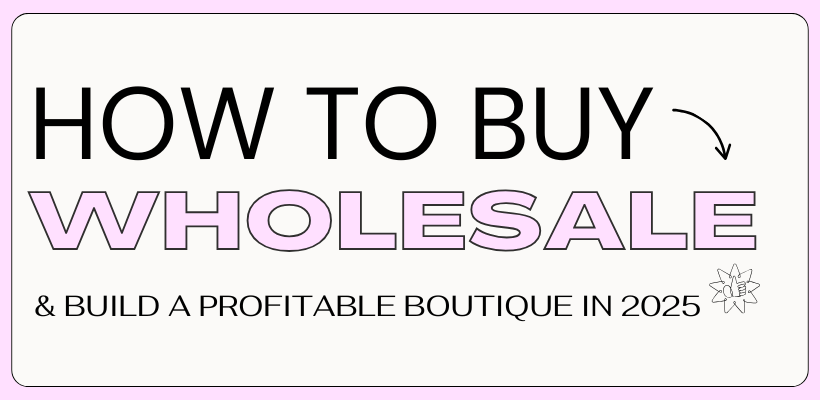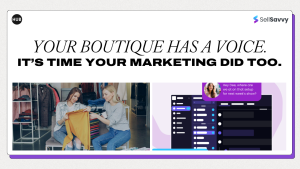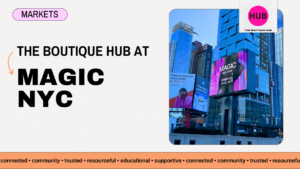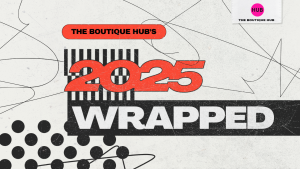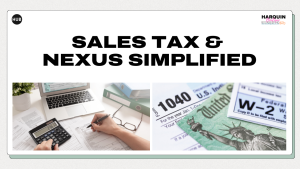Wholesale buying isn’t just about filling racks—it’s about making strategic, data-backed decisions that serve your customers, strengthen vendor relationships, and ultimately boost profitability. In our recent webinar, The Boutique Hub’s Director of Wholesale Samantha Conner tackled the most common challenges boutique owners face and outlined a smart, customer-first approach to buying that drives results. Here are the best takeaways!
1. Know Who You Are Buying For – Who Is Your Customer?
The smartest buying decisions begin with one essential question: Who are you buying for?
Before you hit “add to cart,” get clear on your ideal customer. Think beyond age and location—consider her lifestyle, daily habits, what she values, and how she shops. Is she chasing toddlers while running errands? A full-time professional who wants to look polished without the effort? Your customer avatar should guide every purchase you make, helping you choose pieces that solve problems and spark excitement.
2. Your Boutique’s Value Isn’t Just the Product
What makes your boutique special? It’s not just the clothes on the rack—it’s the experience you offer. From how you style pieces to your in-store atmosphere or online community, you’re selling more than fashion.
If you’re relying on “cute and affordable” as your pitch, it’s time to dig deeper. Value comes in many forms: convenience, styling services, exclusivity, or education. When you buy with that unique value in mind, you create a cohesive brand experience that sets you apart.
3. Choose the Right Vendors (And Don’t Settle)
Not all vendors are created equal. Look for those who offer more than just trendy products—they should also be reliable, communicative, and aligned with your store’s aesthetic and standards.
Before committing to large orders, start small and test new brands. Pay attention to quality, consistency, and customer feedback. Bonus points if they offer fast shipping, support small batches, or have flexible reordering options. Building a solid vendor list is a long-term strategy that pays off with time.
4. Budget by Category, Not Just by Month
It’s easy to overspend when you’re buying without a plan. Set a clear open-to-buy budget—and take it a step further by breaking that budget down by category. How much are you allotting for tops? Denim? Accessories? Set price point goals within each category to keep your assortment balanced.
This not only helps you stay on track financially, but it also ensures your inventory is curated and intentional rather than overstuffed and inconsistent.
5. Think Margin, Not Just Markup
Don’t get caught up in markup alone. What really matters is margin—how much money you’re actually keeping after a sale. Use tools like an ROI calculator to evaluate whether an item is worth the investment based on your average sell-through rate, return policies, and shipping costs.
Small shifts in buying decisions can create a big difference in overall profitability.
6. Marketing and Buying Should Work Together
Buying product is only half the battle—the other half is selling it. Before placing a new order, think ahead: how will you market it? What story does this collection tell? Does it align with upcoming holidays, themes, or promotions?
Plan your buys to support your content calendar and campaigns. When you coordinate delivery dates with social content and team training, you create a smoother and more successful sales flow.
7. Avoid These Buying Mistakes
Even experienced boutique owners fall into these common traps:
- Buying from the first vendor you find
- Ordering in bulk without testing styles first
- Shopping based on personal taste instead of customer data
- Forgetting to plan sell-through strategies
A good rule of thumb? If you can’t explain why you’re buying it and how you’ll sell it, skip it.
8. Explore Private Labeling for Higher Margins
Looking for exclusivity and better profits? Private labeling allows you to create your own branded product line—either by customizing existing vendor products or developing your own. You don’t need to go big at first; start with something simple like branded tags or exclusive prints.
It’s a great way to stand out, build brand loyalty, and gain more control over pricing.
9. Consider Nearshoring as a Buying Strategy
With rising shipping costs and longer lead times, more boutiques are exploring nearshoring—buying from vendors based in Mexico or South America. The proximity often means quicker turnaround, more flexible order minimums, and easier communication.
It’s a strategy worth exploring, especially if you want to diversify your vendor list or reduce overseas delays.
10. Use Inventory Exchanges to Reduce Risk
Buying smart also means having a backup plan. If a style doesn’t move, don’t let it collect dust—consider using a boutique-to-boutique inventory exchange group to sell or swap pieces with other retailers. It’s a great way to recoup costs, try new brands, and avoid markdown overload.
The Bottom Line: Buy With Purpose
Smart buying is less about gut feelings and more about strategy. When you know your customer, stick to a plan, and stay flexible in your sourcing, you create a boutique that feels curated, profitable, and uniquely you.
Looking for a Better Way to Buy?
That’s where Hubventory comes in. It’s the wholesale platform built by boutique owners, for boutique owners. With tools to track your budget, build vision boards, and shop from trusted, curated brands, Hubventory makes it easy to stay organized and buy with purpose.
✅ Shop by margin
✅ Build seasonal boards
✅ Discover exclusive deals
✅ Track your open-to-buy in real time
Ready to make smarter buying decisions? Start shopping on Hubventory today and take control of your inventory like never before.
- Your Boutique Has a Voice. It’s Time Your Marketing Did Too.
 by Shannon Gordon“Your boutique already has a voice customers trust. SellSavvy helps you make sure your marketing finally sounds like it.” Your audience doesn’t need more noise — they want more you. They want connection, personality, and that one-on-one feel that made them fall in love with your brand in the first place. SellSavvy helps you deliver that at scale, turning every customer interaction into an opportunity to sell smarter — not louder.
by Shannon Gordon“Your boutique already has a voice customers trust. SellSavvy helps you make sure your marketing finally sounds like it.” Your audience doesn’t need more noise — they want more you. They want connection, personality, and that one-on-one feel that made them fall in love with your brand in the first place. SellSavvy helps you deliver that at scale, turning every customer interaction into an opportunity to sell smarter — not louder. - The Boutique Hub at MAGIC NYC
 by Shannon GordonThe Hub Team is heading to MAGIC New York again and we couldn’t be more excited! With over 320+ brands, you are sure to find more MAGIC in a (New York) minute!
by Shannon GordonThe Hub Team is heading to MAGIC New York again and we couldn’t be more excited! With over 320+ brands, you are sure to find more MAGIC in a (New York) minute! - The Boutique Hub is Heading to PGA Orlando!
 by Shannon GordonThe Boutique Hub is heading to the PGA Show in Orlando. Tapping into the fast-growing golf apparel market projected to hit $13B by 2032. Golf fashion is evolving beyond the course, creating big opportunities for boutique retailers. The Hub team will be connecting with brands, discovering new trends, and offering live education and retail audits at the event on July 28th. Boutique owners interested in athleisure, activewear, or preppy styles should consider adding golf-inspired looks to their lineup. VIP perks available through The Hub’s exclusive registration link.
by Shannon GordonThe Boutique Hub is heading to the PGA Show in Orlando. Tapping into the fast-growing golf apparel market projected to hit $13B by 2032. Golf fashion is evolving beyond the course, creating big opportunities for boutique retailers. The Hub team will be connecting with brands, discovering new trends, and offering live education and retail audits at the event on July 28th. Boutique owners interested in athleisure, activewear, or preppy styles should consider adding golf-inspired looks to their lineup. VIP perks available through The Hub’s exclusive registration link. - 2025 Wrapped: The Boutique Hub Community by the Numbers
 by Shannon GordonFrom thousands of daily conversations to millions of podcast downloads, 2025 was a powerful year for The Boutique Hub community. This recap breaks down the biggest wins, trends, and milestones—and shows how retailers can turn that momentum into a clear plan for an even stronger year ahead.
by Shannon GordonFrom thousands of daily conversations to millions of podcast downloads, 2025 was a powerful year for The Boutique Hub community. This recap breaks down the biggest wins, trends, and milestones—and shows how retailers can turn that momentum into a clear plan for an even stronger year ahead. - Sales Tax & Nexus Simplified
 by Shannon GordonSales tax and nexus can feel like one giant headache — but it doesn’t have to be. If you sell across state lines, even online, you’re expected to collect and remit sales tax based on where your customers live… and those rules change constantly. Understanding when you’ve triggered nexus (and in which states) is the key to staying compliant and avoiding costly penalties. This guide breaks it all down in simple terms, so you can finally feel confident about what you owe, where you owe it, and how to stay ahead of it.
by Shannon GordonSales tax and nexus can feel like one giant headache — but it doesn’t have to be. If you sell across state lines, even online, you’re expected to collect and remit sales tax based on where your customers live… and those rules change constantly. Understanding when you’ve triggered nexus (and in which states) is the key to staying compliant and avoiding costly penalties. This guide breaks it all down in simple terms, so you can finally feel confident about what you owe, where you owe it, and how to stay ahead of it.
